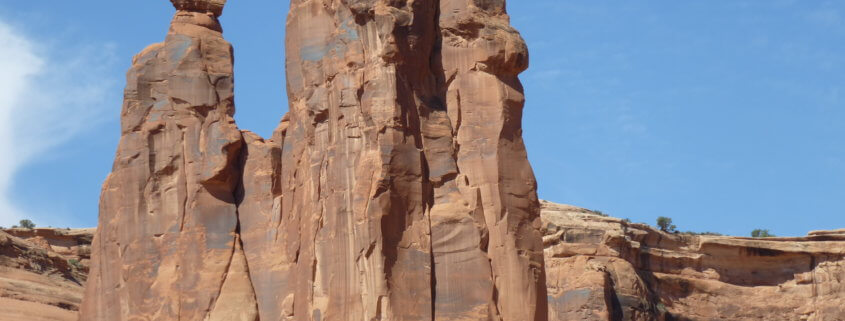Hike the Hoodoos!

Hoodoos in Bryce Canyon National Park
Bryce Canyon National Park, Utah – inspiration is everywhere!
“Hoodoos” are pillars of dramatically shaped colored stone, like armies of Chinese terra cotta warriors marching along a vast pink and salmon amphitheater. These fanciful creations, made by millennia of erosion and geological forces, cast a spell on all who visit. When my husband Richard and I were recently there, we might well have thought that the native language of the Hoodoos was French, given the legions of French people in rented caravans who flocked to gasp Gallicly at the magnificent scenery. We also encountered delightful Dutch families on spring school leave, resolute Germans, a few Italians, and tight formations of Asians, swathed in layers against the bitter 30-mile-an-hour winds and temperatures barely into the 40s. Americans were decidedly in the minority.
The scouring winds made the air bracing, clean and fresh, scented with ponderosa, pinion pine and juniper, and the night skies thick with stars.
This land was named for Mormon pioneer Ebenezer Bryce who came with his family in 1875 to build settlements, a road to the plateau top, and ultimately, an irrigation canal, created by diverting the Sevier River—by hand.

Cabin in Bryce Canyon National Park
We stayed in a charming 1920s vintage cabin, one of several not far from the rim of the canyon. The Lodge, now on the National Register of Historic Places, was built by the Union Pacific Railroad with the intention of making Bryce Canyon part of their new loop tour of the southwest. The Lodge itself is a rustic charmer, with faithfully reproduced pine furniture grouped around the massive stone fireplace. The food was surprisingly good in the dining room – elk chili, perfectly seared tuna, “Ebenezer’s trout,” quinoa and roasted vegetables.
Hiking around the rim, I met a woman from Paris, a painter, and when I asked her if she planned to paint what she’d seen and photographed, she said, “I’m an abstract painter, so no, not the canyon, but ah, yes, the colors! The pinks!” It was far too windy and cold to sketch, and after several hours on the trail, we retreated to the Lodge to read and doze in front of the roaring fire.
Sunrise is magnificent here—but then, so is sunset—lighting or extinguishing the hoodoos one by one, or in clusters. Just be prepared to bundle up, unless you’re here in August. A fleece, gloves, a down vest, hoodie, and even earmuffs would have been welcome!

Sunrise, Bryce Canyon
You can easily fill a day or two, driving to viewpoints around the park, or to Mossy Cave Trail, an easily managed hike along “Tropic Ditch,” the canal carved in 1892 by those intrepid Mormon settlers. Even now, it provides water to nearby Tropic and Canyonville. Snow was still melting in the cave at the end of the trail, while wild flowers were just beginning to make an appearance in the valley.

The Three Gossips
Should you come, be sure to drive “Scenic Byway 12” where you’ll see the Red Canyon, Grand Staircase-Escalante National Monument, and more – miles and miles of jaw dropping panoramas, no two alike: enormous boulders that looked spray-painted in bands of chocolate, pale green, purple, magenta; lunar grey and cream landscapes; bizarre “melting” rocks that had us exclaiming, “Look! Jabba the Hut!” or “Gaudi!” or “Henry Moore!” Everywhere are living sculptures you’re tempted to name, and indeed, should you venture further to Arches or Canyonlands National Parks you’ll shed your Bryce layers and hike out to meet The Three Gossips, Sheep Rock, Balanced Rock, and Delicate Arch—where “Indiana Jones and the Last Crusade” was filmed.

Richard and I at the Lodge, Bryce Canyon
After a day of hiking you’ll be ready to roll into nearby Moab and slake your thirst with a Hoodoo Ale.

Intriguing that Europeans love this site. For them it must seem completely different and especially beautiful and worth the travel of thousands of miles to get to it. I can imagine the beauty from what you describe.
But hoodoo? Where does that term come from?
The photographs are great: wish they could be enlarged to see more of the detail — and the color.
The “hoodoos” (I think some relatives of them live in Cappadocia, Turkey) are named for “voo doo”, or a variant, because they’re so spooky and appear to be magical.